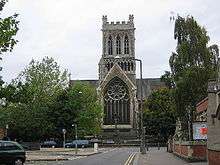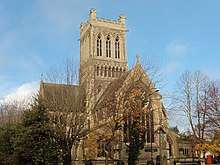St Paul's, Burton upon Trent
St Paul's Church is a Church of England parish church in Burton upon Trent, Staffordshire England. The church, on St Paul's Square and near the Town Hall, opened in 1874 and was designed by the architects James M. Teale and Edmund Beckett Denison (later created Lord Grimthorpe). Later additions are by G. F. Bodley.[1] The building is listed as Grade II*.
| St Paul’s Church, Burton upon Trent | |
|---|---|
 St Paul’s Church, Burton upon Trent | |

| |
| Denomination | Church of England |
| Churchmanship | Anglo Catholic |
| Website | St Paul's webpage |
| Administration | |
| Diocese | Diocese of Lichfield |
| Province | Province of Canterbury |
| Clergy | |
| Vicar(s) | Fr Stanley Monkhouse |
| Curate(s) | Fr Pete Orton, Fr Phillip Jefferies (retired) |
| Laity | |
| Churchwarden(s) | Mike Mear, John Woolley |
The church is in the diocese of Lichfield. Since 2005, St Paul's has been part of a combined parish with St Aidan's, Shobnall. Regular Sunday Masses are at 09.30 (Solemn Mass) and weekday masses are on Friday at 12.30. The church is normally open Mondays to Fridays 12 noon to 2.00 pm as well as for regular services
History
A mission in Borough Road, Burton was opened in 1865 from Christ Church at the suggestion of Michael Thomas Bass. By 1872 the mission was known as St Paul's and in 1873, it was assigned an ecclesiastical district, created out of the parishes of Christ Church, Holy Trinity, and St Modwen's. A new church, St Paul's, was opened in 1874 on a site soon known as St Paul's Square,[1] with Michael Thomas Bass paying for the erection of the church and vicarage at a cost of £50,000 (equivalent to £4,676,285 in 2019).[2] The church was consecrated on 7 April 1874 by the Bishop of Lichfield, George Augustus Selwyn.
The building

St Paul's church was built to the design of J. M. Teale of Doncaster with assistance from Sir Edmund Beckett Denison (later Edmund Beckett, 1st Baron Grimthorpe). It uses Coxbench and Ancaster stone in a geometrical, decorated style.[1] The shape is cruciform with an aisled three-bay chancel, quatrefoil in cross section and five-bay nave, as well as north and south transepts, and a square central tower.[1] The tower, of 123 feet, houses a ring of ten bells; the original eight bells were recast in 1912 and two further bells were added in 1922.[1]
The column capitals and label stops throughout the church were designed by a S. Tinkler of Derby and show naturalistic foliage, fruit, and animals with those in the nave representing the twelve months of the year. All the windows have early decorated style tracery, with ballflower ornamentation in the chancel. The nave and transept clerestories have triple lancets, while the clerestories in the chancel have carved spherical triangles. The nave roof has traceried spandrels and principals supported on clustered wall shafts. There are six windows (one in the south aisle and five in the narthex) designed in an Arts and Crafts style by Archibald John Davies of the Bromsgrove Guild. They date from 1919–34.[1]
Between 1889 and 1901 the eastern arm and south transept were considerably altered to the design of George Frederick Bodley, at the expense of Michael Bass, 1st Baron Burton. In 1889, the south chancel aisle was converted into a chapel for daily services and two years later an external sacristy was added on the north side of the chancel with an internal porch added to the south transept door.[1]
The chancel and sanctuary roof were painted and a canopy was added to the original large circular stone pulpit. The organ cases, one in the chancel and one high in the south transept are both by Bodley. The chancel floor was also relaid with red and white marble. The reredos was replaced by one designed by ecclesiastical and architectural sculptor Robert Bridgeman that depicted the Crucifixion in a central panel of red shawk stone surrounded by the saints.[1] The original reredos was transferred to St George's Church, Derby in 1895[3] and is now in St Christopher's, Ellistown.
A number of other changes were made in the 20th century, paid for primarily by parishioners. A western narthex was added in 1910 as a memorial to Baron Burton, who had died the previous year. A calvary war memorial was erected in the churchyard in 1920 and a bishop's chair of stone was built into the sanctuary wall in 1931. The two west bays of the nave and the narthex were converted into a church hall in 1979 and at the same time several items were added from the former chapel of ease of St Margaret, including a wooden lectern by Morris and Co., a painting of the Crucifixion by Charles Edgar Buckeridge[4] which was placed by the south door, statues of Alpha and Omega which were added to the south chancel aisle chapel, a banner of the Queen of Heaven probably by the Comper school, and statues of St Margaret of Antioch and St Michael slaying the Dragon.
Arthur Mee wrote of the decoration of St Paul's: "All is nobly rich and beautiful in this wonderful church".[5]
In 1950 the church became a Grade II* listed building.[6]
Organ
In 1894-5 the original three manual organ, by William Hill & Sons of London, was replaced by a four manual organ, the first built entirely by the Hope-Jones Electric Organ Company Ltd.[7] The Hope-Jones organ was itself replaced in 1985[1] when parts including the console were removed to the Theatre Organ Heritage Centre of the Lancastrian Theatre Organ Trust in Eccles, Greater Manchester.[8] The Hill organ was moved to Trinity Methodist Church, in George Street in 1896, and then in 2012 to Sankt-Afra-Kirche in the Berlin suburb of Gesundbrunnen.[9][10]
The church now contains an organ formerly in the Central Methodist Church, Saltergate, Chesterfield. It is in the north chancel aisle and its specification can be found on the National Pipe Organ Register. The south transept organ case is now empty apart from a few large pipes from the earlier instruments.
List of organists
- Dr Arthur Blurton Plant, 1874–1914 (born in 1853 he was organist and choirmaster from the church's consecration in 1874 until his death. In forty years as organist of St Paul's, he only missed one Sunday.)
- Arthur William Keith Plant, 1914–40 (son of A. B. Plant)
- Dennis Townhill, 1942–43[11]
- Walter Cox, 1945–68
- Terence W. Bennett, 1977–84 (transferred to St Modwen's.)
Vicars
- James Henry Fish, 1874 until his death in 1887
- Frederic Hicks Beaven, 1887-1901 (later Bishop of Mashonaland)
- Rev Joseph John Gabbett Stockley, MA, 1901[12]-1919 (later Canon of Lichfield Cathedral)
- Rev. The Hon. Sydney George William Maitland, 1919–1927
- Paul Andrew Farthing, 2005-2013
- William Stanley Monkhouse, 2014 onwards (also Vicar of St Modwen's Church)
References
- "'Burton-upon-Trent: Established church'". A History of the County of Stafford: Volume 9: Burton-upon-Trent: 107–130. 2003. Retrieved 6 July 2010.
- UK Retail Price Index inflation figures are based on data from Clark, Gregory (2017). "The Annual RPI and Average Earnings for Britain, 1209 to Present (New Series)". MeasuringWorth. Retrieved 2 February 2020.
- "New reredos for St George's Church". Derby Daily Telegraph. England. 15 April 1895. Retrieved 4 June 2017 – via British Newspaper Archive.
- Goodall, John (2015). Parish Church Treasures: The Nation's Greatest Art Collection. Bloomsbury Publishing. ISBN 9781472917638.
- Staffordshire by Arthur Mee; 1937
- Historic England. "Details from listed building database (1288714)". National Heritage List for England. Retrieved 30 September 2015.
- Essay by Don Hyde that won the Simonton Literary Prize, 2007
- Colin Pykett, Robert Hope-Jones: The evolution of his organ actions in Britain from 1889 to 1903
- "Church organ to make Germany its new home" Burton Mail 10 January 2012
- http://www.st-afra-berlin.de/index.php/orgeltagebuch
- Who's Who in Music. Shaw Publishing Co. Ltd. London. First Post-War Edition. 1949–50
- Kelly's Directory of Staffordshire, 1912